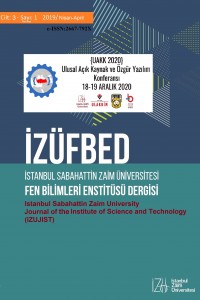Öz
Astronomi ve astronomik kavramlar insanoğlunun yüzyıllardır merak ettiği konular arasında yer almaktadır. Özellikle çocuklar, erken yaşlardan itibaren çevrelerini gözlemlemeye, Uzay, Dünya ve diğer gök cisimleri hakkında sorular sormaya başlarlar. Planetaryumlar, okul öncesi dönem çocukları için soyut olan bu kavramları somutlaştırmaya yarayan öğrenme ortamlarındandır. Bu çalışmada, açık kaynak kodlu planetaryum örneklerinden Stellarium ile Celestia incelenmiş ve okul öncesi fen eğitiminde kullanılabilirliği tartışılmıştır.
Anahtar Kelimeler
Açık kaynak kodlu yazılım Planetaryum Okul öncesi eğitim Fen
Kaynakça
- Ampartzaki, M. & Kalogiannakis, M. (2016). Astronomy in early childhood education: A concept-based approach. Early Childhood Education Journal, 44, 169-179.
- Bozdoğan, A. E. (2020). ‘Planetaryum’ konusunda yayınlanan eğitim araştırmaları makalelerinin Web of Science veri tabanına dayalı bibliyometrik değerlendirilmesi. OPUS Uluslararası Toplum Araştırmaları Dergisi, 16(27), 150-173.
- Celestia. (2020). Erişim adresi https://celestia.space/.
- Demir, N. ve Öner Armağan, F. (2018). Okul dışı öğrenme ortamlarına yönelik fen bilgisi öğretmenlerinin görüşleri. Journal of Social and Humanities Sciences Research (JSHSR), 5(30), 4241-4248.
- Hu, J., Gordon, C., Yang, N., & Ren, Y. (2021). ‘Once Upon A Star’: A science education program based on personification storytelling in promoting preschool children’s understanding of astronomy concepts. Early Education and Development, 32(1), 7-25.
- Hughes, S. W. (2008). Stellarium–a valuable resource for teaching astronomy in the classroom and beyond. Science Education News (SEN), 57(2), 83-86.
- İzgi Onbaşılı, Ü. ve Siper Kabadayı, G. (2019). Okul öncesi dönemde çocukların astronomi konusunda temel kavramlarla ilgili bilgilerinin incelenmesi. Turkish Journal of Primary Education, 4(2), 85-97.
- Kallery, M. (2011). Astronomical concepts and events awareness for young children. International Journal of Science Education, 33(3), 341-369.
- Lind, K. K. (1999). Science in early childhood: Developing and acquiring fundamental concepts and skills, dialogue on early childhood science, mathematics, and technology education. Washington, DC: AAAS.
- National Research Council (2001). Astronomy and astrophysics in the new millennium. Washington, DC: The National Academies Press.
- Ogelman, H. G. (2012). Teaching preschool children about nature: A project to provide soil education for children in Turkey. Early Childhood Education Journal, 40(1), 77–185.
- Persson, J. R. and Eriksson, U. (2016). Planetarium software in the classroom. Physics Education, 51(2), 1-9.
- Sharp, J. G. (1999). Young children’s ideas about the Earth in space. International Journal of Early Years Education, 7(2), 159-172.
- Stellarium. (2020). Erişim adresi http://stellarium.org/.
- Timur, S., Yalçınkaya-Önder, E., Timur, B. ve Özeş, B. (2020). Astronomy education for preschool children: Exploring the sky. International Electronic Journal of Elementary Education, 12(4), 383-389.
- Zotti, G. & Wolf, A. (2019). Stellarium 0.19. 0 User Guide, 2019. Available at https://stellarium.org.
Öz
Astronomy and astronomical concepts are among the topics that mankind has been wondering about for centuries. Especially children begin to observe their surroundings and ask questions about Space, Earth and other celestial bodies from an early age. Planetariums are one of the learning environments that help to embody these abstract concepts for preschool children. In this study, Stellarium and Celestia, two open source planetarium examples, were examined and their usability in preschool science education was discussed.
Anahtar Kelimeler
Open source software Planetarium Preschool education Science
Kaynakça
- Ampartzaki, M. & Kalogiannakis, M. (2016). Astronomy in early childhood education: A concept-based approach. Early Childhood Education Journal, 44, 169-179.
- Bozdoğan, A. E. (2020). ‘Planetaryum’ konusunda yayınlanan eğitim araştırmaları makalelerinin Web of Science veri tabanına dayalı bibliyometrik değerlendirilmesi. OPUS Uluslararası Toplum Araştırmaları Dergisi, 16(27), 150-173.
- Celestia. (2020). Erişim adresi https://celestia.space/.
- Demir, N. ve Öner Armağan, F. (2018). Okul dışı öğrenme ortamlarına yönelik fen bilgisi öğretmenlerinin görüşleri. Journal of Social and Humanities Sciences Research (JSHSR), 5(30), 4241-4248.
- Hu, J., Gordon, C., Yang, N., & Ren, Y. (2021). ‘Once Upon A Star’: A science education program based on personification storytelling in promoting preschool children’s understanding of astronomy concepts. Early Education and Development, 32(1), 7-25.
- Hughes, S. W. (2008). Stellarium–a valuable resource for teaching astronomy in the classroom and beyond. Science Education News (SEN), 57(2), 83-86.
- İzgi Onbaşılı, Ü. ve Siper Kabadayı, G. (2019). Okul öncesi dönemde çocukların astronomi konusunda temel kavramlarla ilgili bilgilerinin incelenmesi. Turkish Journal of Primary Education, 4(2), 85-97.
- Kallery, M. (2011). Astronomical concepts and events awareness for young children. International Journal of Science Education, 33(3), 341-369.
- Lind, K. K. (1999). Science in early childhood: Developing and acquiring fundamental concepts and skills, dialogue on early childhood science, mathematics, and technology education. Washington, DC: AAAS.
- National Research Council (2001). Astronomy and astrophysics in the new millennium. Washington, DC: The National Academies Press.
- Ogelman, H. G. (2012). Teaching preschool children about nature: A project to provide soil education for children in Turkey. Early Childhood Education Journal, 40(1), 77–185.
- Persson, J. R. and Eriksson, U. (2016). Planetarium software in the classroom. Physics Education, 51(2), 1-9.
- Sharp, J. G. (1999). Young children’s ideas about the Earth in space. International Journal of Early Years Education, 7(2), 159-172.
- Stellarium. (2020). Erişim adresi http://stellarium.org/.
- Timur, S., Yalçınkaya-Önder, E., Timur, B. ve Özeş, B. (2020). Astronomy education for preschool children: Exploring the sky. International Electronic Journal of Elementary Education, 12(4), 383-389.
- Zotti, G. & Wolf, A. (2019). Stellarium 0.19. 0 User Guide, 2019. Available at https://stellarium.org.
Ayrıntılar
| Birincil Dil | Türkçe |
|---|---|
| Bölüm | Makaleler |
| Yazarlar | |
| Yayımlanma Tarihi | 30 Nisan 2021 |
| Gönderilme Tarihi | 16 Ocak 2021 |
| Kabul Tarihi | 23 Şubat 2021 |
| Yayımlandığı Sayı | Yıl 2021 Cilt: 3 Sayı: 1 |
Cited By
Augmented Reality in Early Childhood Education: The Effect of Quiver Application on Science Learning
e-Kafkas Eğitim Araştırmaları Dergisi
https://doi.org/10.30900/kafkasegt.1367709
TÜRKİYE'DE OKUL ÖNCESİ FEN EĞİTİMİNE YÖNELİK YAPILAN ARAŞTIRMALARIN ANALİZİ: META-SENTEZ ÇALIŞMASI
Fırat Üniversitesi Sosyal Bilimler Dergisi
https://doi.org/10.18069/firatsbed.1232738
Bu eser Creative Commons Atıf-GayriTicari 4.0 Uluslararası Lisansı ile lisanslanmıştır.


